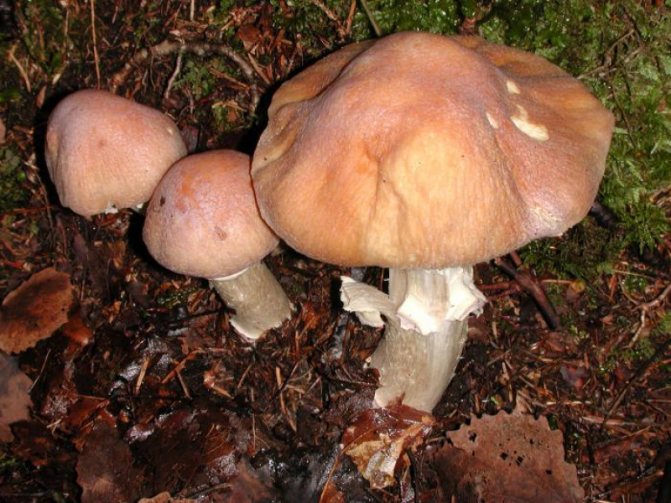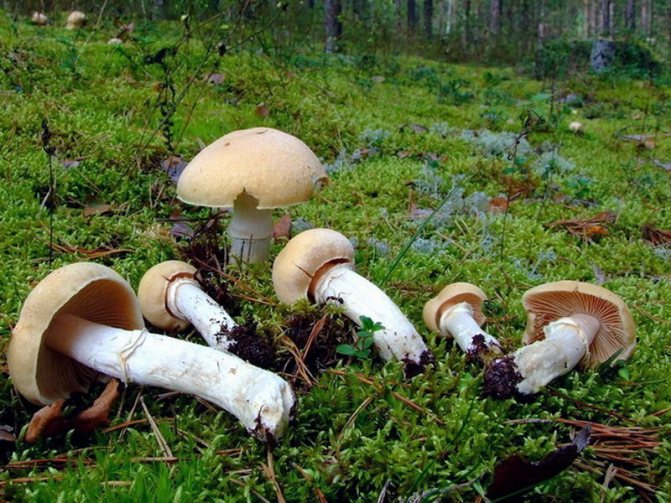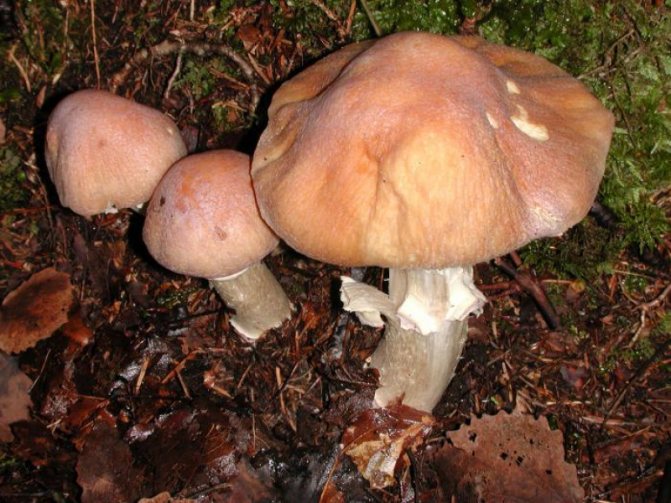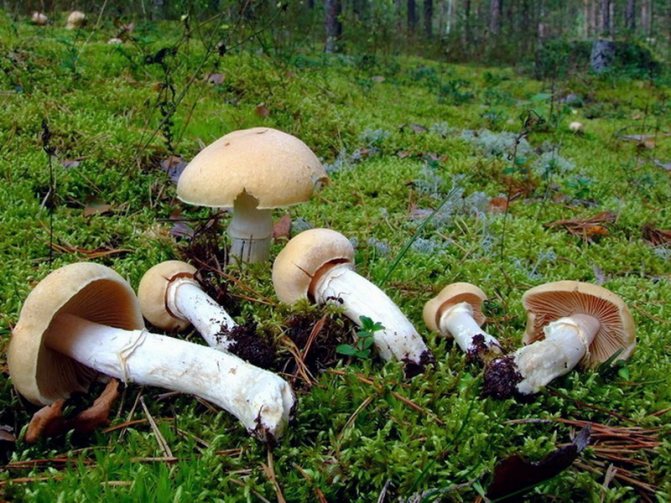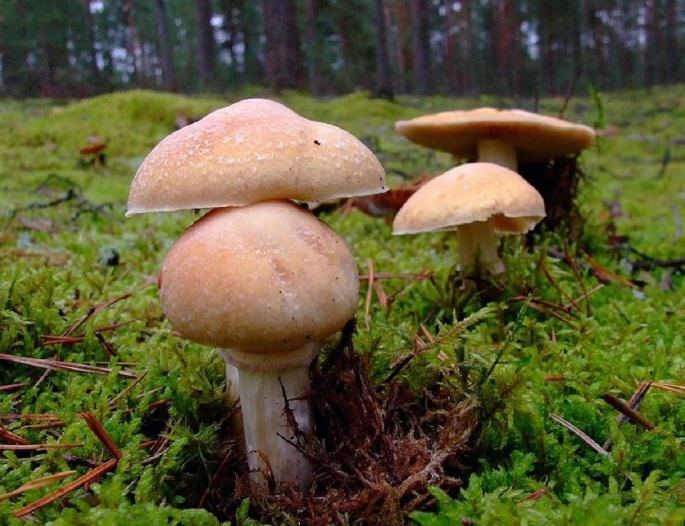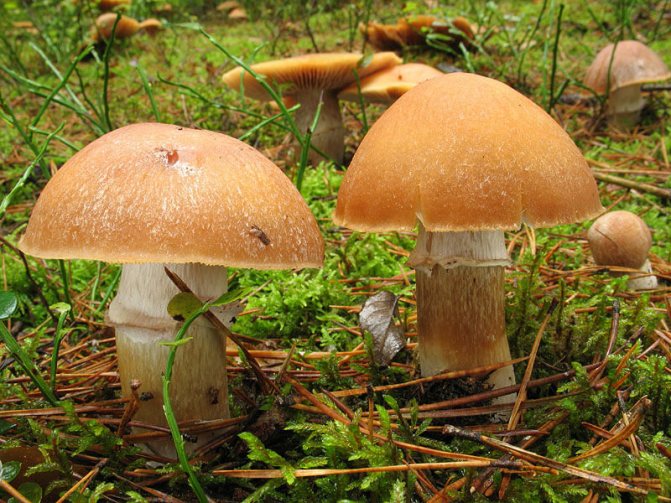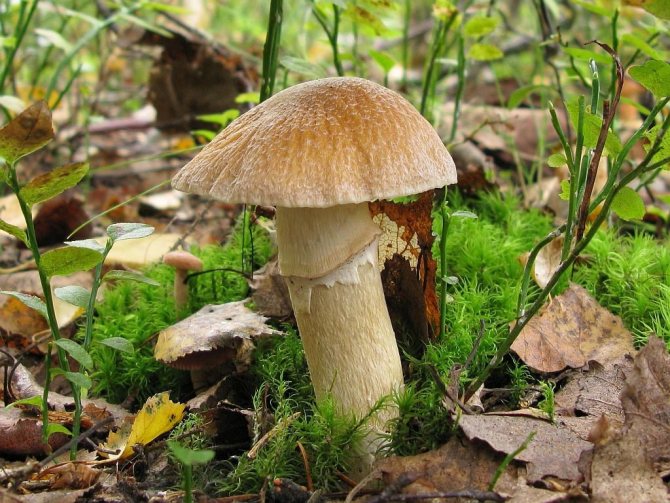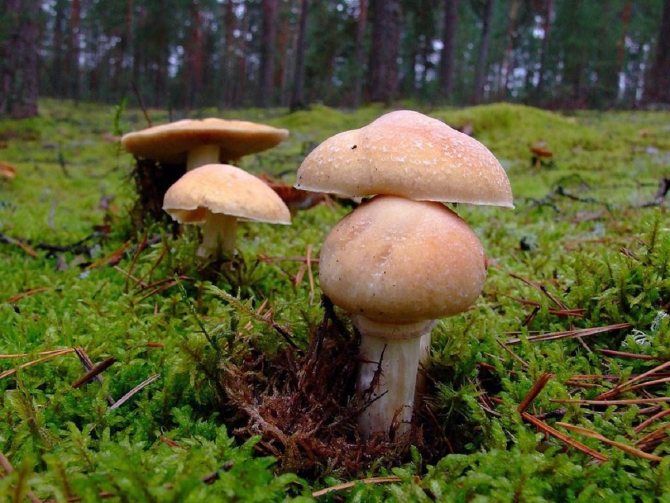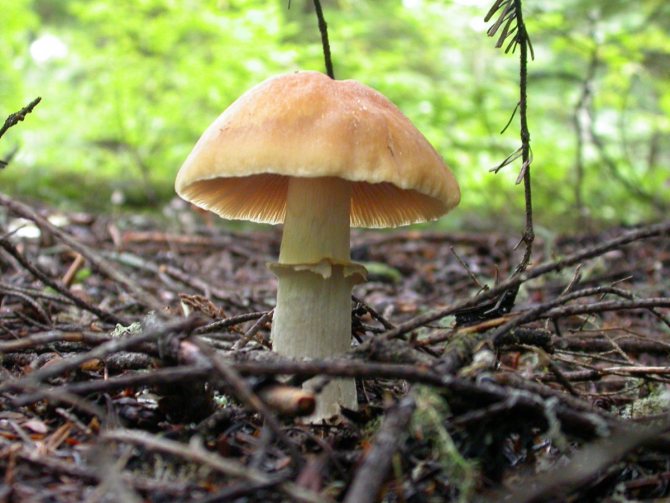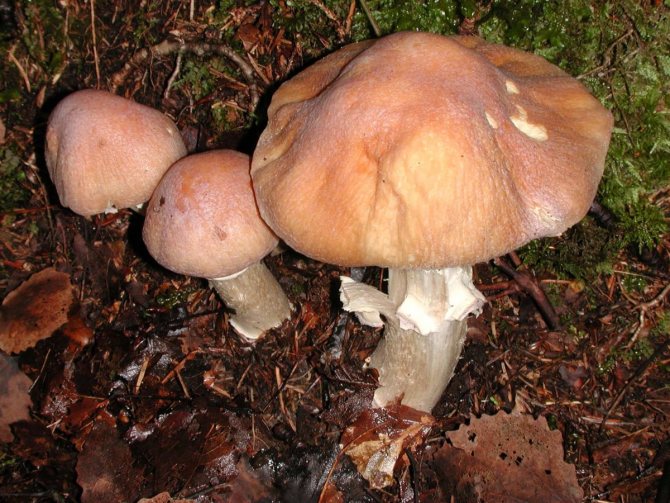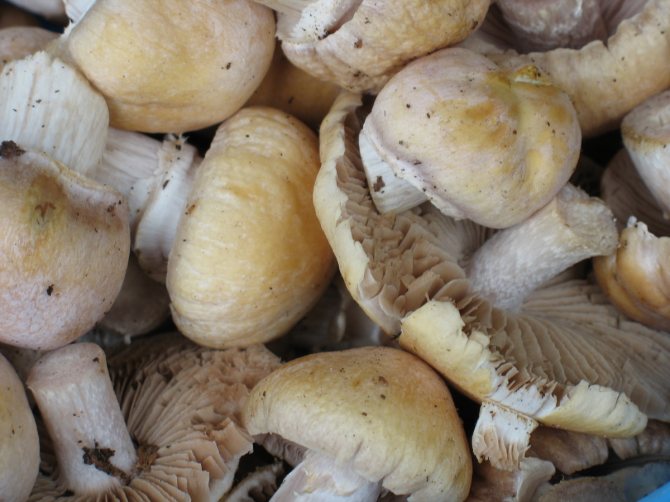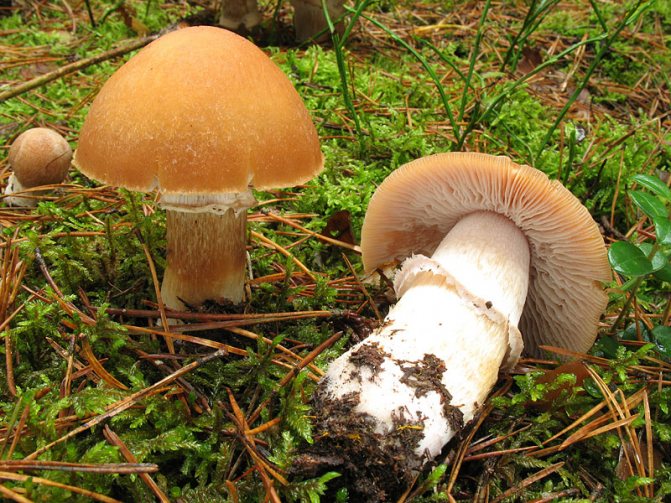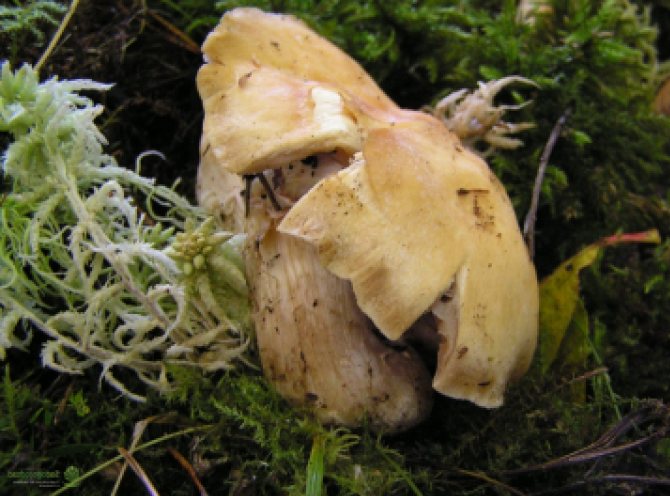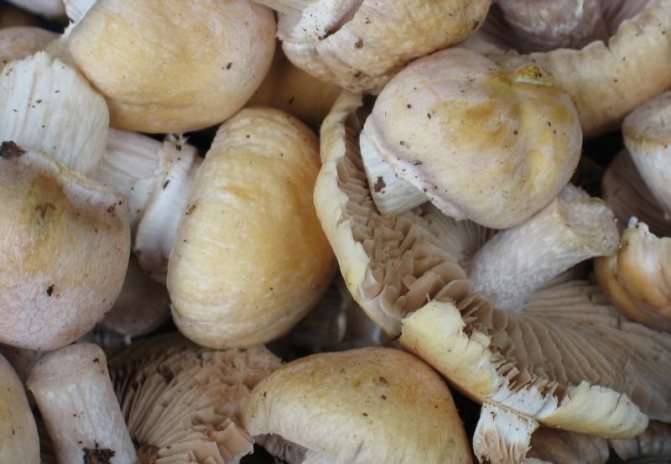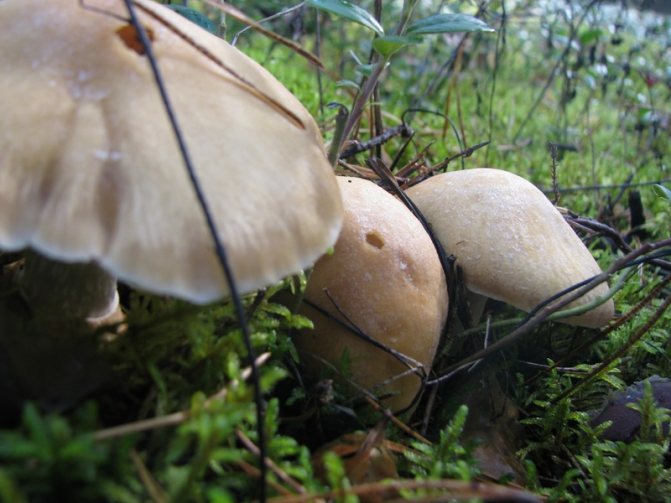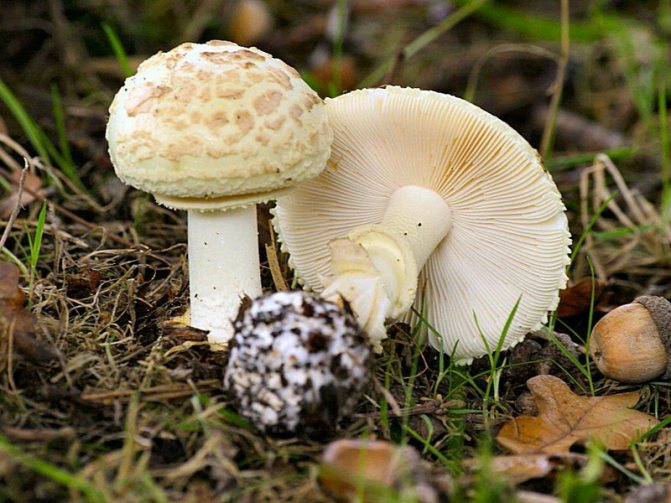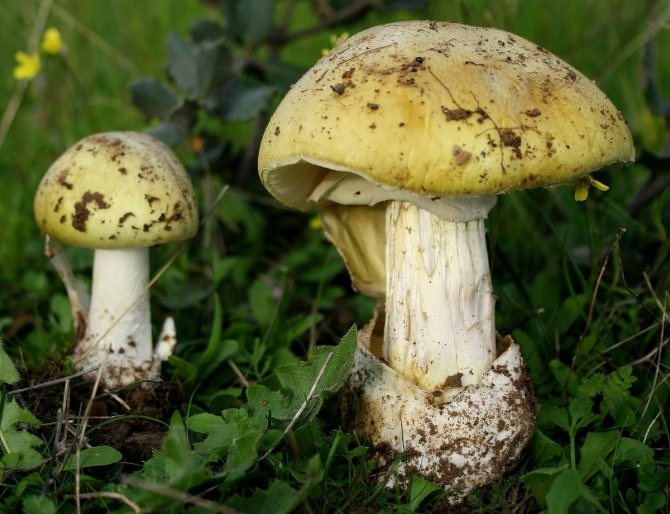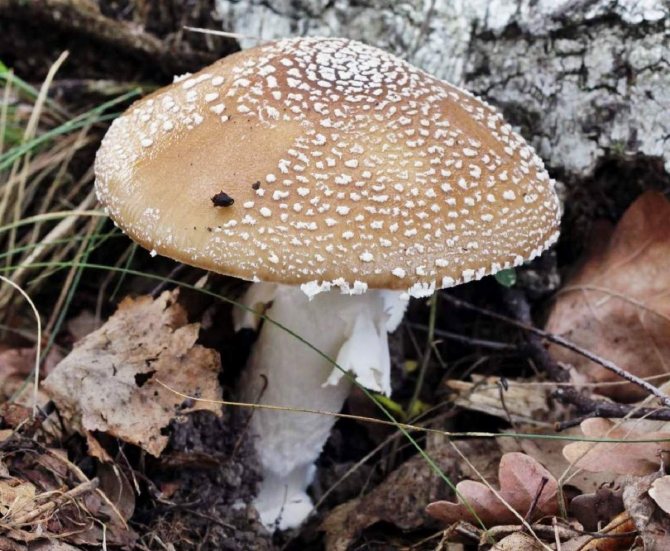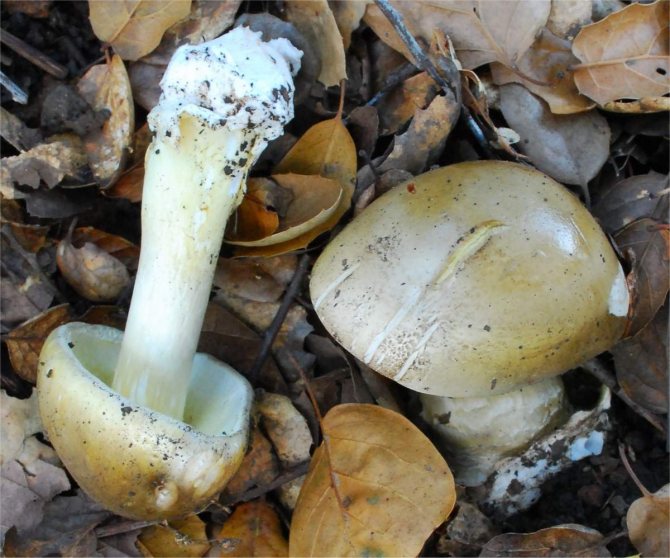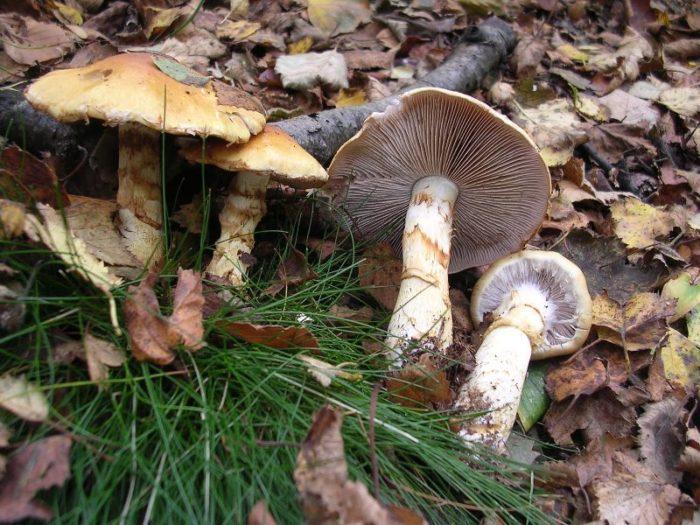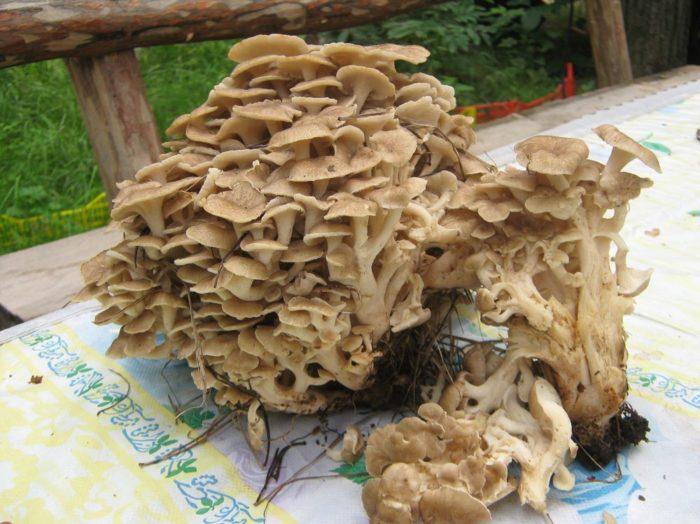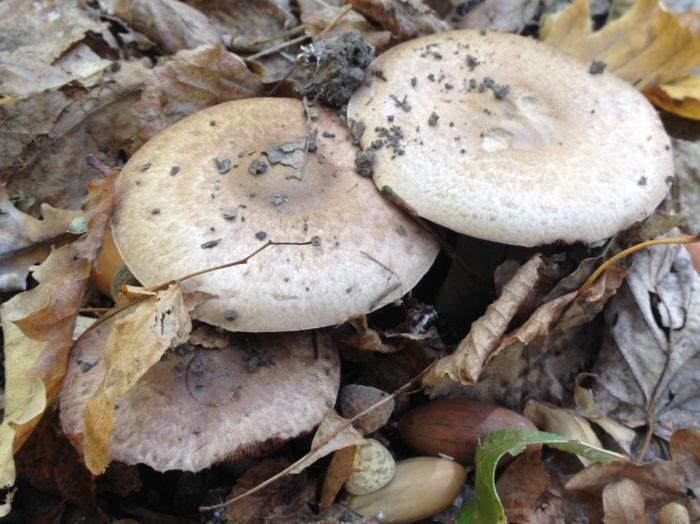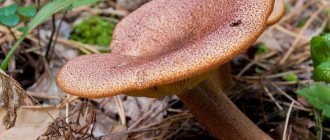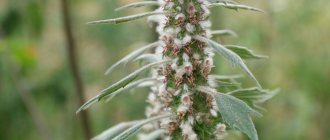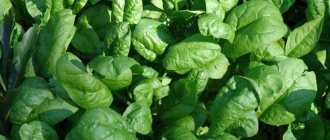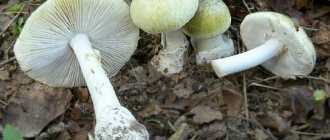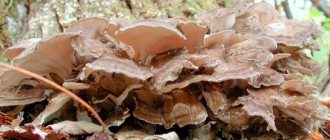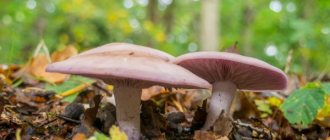Most experienced mushroom pickers do not even know what a chicken mushroom looks like. Although it is safe to say that they encountered them, they simply did not pay attention. After all, chicken mushrooms look like toadstools and rarely cause an appetite, like the same boletus. And in the photo, under a beautiful angle, they do not cause delight.
But they do not pay attention to this variety of mushrooms in vain. The description of this mushroom in many European countries suggests that it tastes almost similar to the well-known champignons.
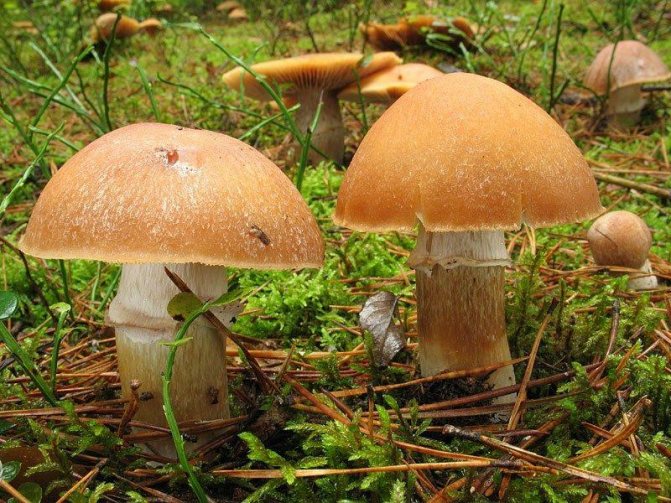
How do they look
In order not to chop toadstools instead of these mushrooms, you need to have an excellent idea of how chickens generally look. The cap of the ringed cap is rounded, resembling the shape of an egg. The color of the hat has a light brownish tint (the color is very close to the color of the eggshell of a hen's egg). The diameter of the hat of a young mushroom is approximately 5 centimeters, in old ones it is an average of 10 centimeters.
Initially, in a young state, the mushroom resembles a leg with a chicken egg on it. Over time, as the chicken begins to age, its hat begins to unfold. She begins to turn into a real cap. The edges begin to align, the film between the inner part and the cap breaks and forms a ring.
If you turn the mushroom over, you can see the plates, which over time become overgrown with spores. In young fruits, the plates have a light shade. But with age, the color becomes more and more dark. When the cap is closed, its plates are light yellow, when the cap is opened, the color changes to dark yellow. With aging, the color becomes rusty, light brown.
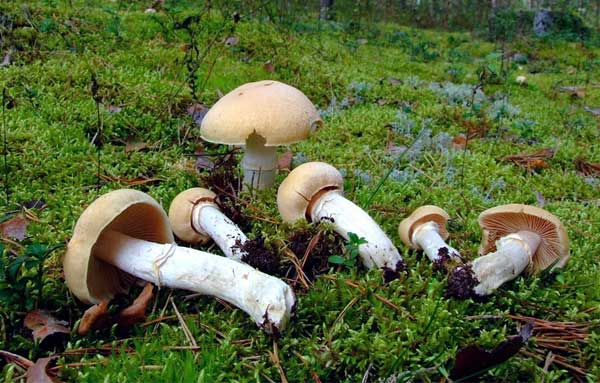

The top of the cap is covered with wrinkles and a light white bloom. In places, plaque accumulates and is somewhat reminiscent of the white spots of the fly agaric. The largest clusters are formed in the region of the edges of the cap.
The chicken leg is straight, with an annular film in the middle. The bottom is slightly thicker than the base of the hat. The surface is smooth, and closer to the top may have a slight coating. The color of the stem is pale yellow. As it approaches the root, it becomes more pronounced.
Ring cap description.
The ringed cap is part of the Webinnikov family, belongs to the genus Rosites. On the territory of Europe, the bell-cap is the only representative of this genus. This mushroom is also popularly called the cobweb, the Turk, the pale rosistes and the chicken. To have an idea of how it looks and what is the difference in its external characteristics, consider a detailed description.
- Leg.
The bell cap has a cylindrical leg, which expands at the base. The maximum height of the mushroom stalk is 12 cm, and its diameter ranges from 1 to 3 cm. In section, the stalk is solid, without cavities, fibrous. Closer to the cap, a filmy ring is always present, which tightly wraps around the stem and is painted white in young mushrooms, but tends to yellow with age. The surface of the leg, close to the cap, is covered with flaky scales, and the color is ocher-white.
- Hat.
In young mushrooms, the cap can be hemispherical, and later takes on the shape of a cap, which is why the mushroom received such a name. With age, the cap may flatten. The diameter of the caps of the ringed cap is from 5 cm to 15 cm, the edges are tucked inward, and, as a rule, are uneven.Barely noticeable stripes are observed along the edges of the cap, and the main color of the surface skin is dirty yellow, ocher or wheat. The skin is permeated with small wrinkled folds, the top is covered with a fibrous bloom, a light, pearl shade.
- Pulp.
At the place of the cut in the area of the cap, the flesh is loose, has a pleasant mushroom aroma and rich taste. At the leg, the flesh is dense and fibrous, with age it can become very tough. For this reason, the legs of old mushrooms are not eaten. After cutting, after 15-30 minutes, the pulp turns slightly yellow, and initially white or white-yellow.
- Disputes and records.
The color of the spore powder is orange-brown, rarely brown or ocher. The spores are small, ocher-colored, warty or almond-shaped. The plates are of different lengths, yellow, grow to the stem. With age, they can darken and acquire a brownish tint.
Where do they grow
Despite its low popularity, the mushroom grows in many European and Asian countries. Also common in the States.
The best soil for the development of colonies is considered to be acidic. You can determine the acidity of the soil by the plants that grow on it. If blueberries come into view, then with 100% certainty we can say that there is a family of chickens somewhere nearby.
There are a lot of chickens in Belarus. Also, they are common in central Russia in swampy areas.
You can collect them from the beginning of July until the onset of frost. These are family fruits that grow in groups. Often, the group forms a semicircle.


Unfortunately, most people consider the swamp to be poisonous and bypass it. But experienced mushroom pickers who were lucky enough to taste the "meat" of the chicken assure that they have no equal in taste.
How to salt mushrooms in jars for the winter - a simple recipe with step by step photos
Most mushroom pickers prefer familiar and proven mushrooms. For example, whites are most in demand due to their ease of collection and preparation. But you can also salt other mushrooms for the winter, which have a rather unusual taste. Various types of milkmen are ideal for salting: young mushrooms retain their density and are quite easily salted at home.
Ingredients for easy pickling of mushrooms for winter in jars
- milkmen -3 kg;
- garlic - 6 cloves;
- salt -150 g;
- dill umbrellas - 3 pcs.;
- leaves of currants, cherries, horseradish - to taste.
Using the mushroom
It is very tasty. Use podotukh for cooking, frying, pickling. In terms of taste and nutritional qualities, the chicken belongs to the 4th category. That is, the mushroom is considered unpopular and not of any particular benefit to the body.
Young, unopened mushrooms are most suitable for cooking. It is these fruits that are best suited for pickling, drying, frying.
In Russia, they hardly talk about its healing properties. Yes, and there are few people who can generally imagine that a bogeyman can be useful. But in Belarus, he is very much appreciated. In folk medicine, it is used as a compress to treat inflammation of the lymph nodes. For this, dried mushrooms are mixed with honey and bacon. Then, the resulting gruel is applied to the swollen lymph nodes.
Also, the brine prepared from it was used to treat a hangover.
Important! The mushroom is absolutely edible. It can be cooked even without pre-cooking. But experienced mushroom pickers still advise to boil the caps for 10-12 minutes.
Going into the forest to harvest mushroom crops, an important rule is to always take only those mushrooms that you are sure of. That is why chicken mushrooms (they are also ringed caps and rosites) often remain intact, to the delight of experienced mushroom pickers. Among lovers of "quiet hunting", few people know about this amazingly tasty and useful gift from the forest.
Features of cooking chickens
Chickens are versatile gastronomically and are subject to any heat treatment. They are usually boiled, fried, or homemade for the winter. Young mushrooms are considered the most appetizing.
How much time to cook
Do not boil them too much. 5-10 minutes of boiling is quite enough when it comes to processing before further cooking.
On a note!
If you plan to harvest chickens for the winter, boil them for about 25 minutes.
Fried mushrooms in a pan
The caps can be fried fresh or pre-boiled. Fried cockerels in batter are extraordinarily tasty. The way to prepare them is simple:
- The peeled caps are dipped in a batter of flour, salt and eggs.
- Breaded in breadcrumbs.
- Vegetable oil is poured into a hot frying pan so that the mushrooms are deep-fried.
- The heat is reduced and the cockerels are placed in a skillet. When they are browned, they are turned over and browned on the other side.
- Cooking time is 5-7 minutes. For crispy frying, you can send the mushrooms to the oven for half an hour at a temperature of 180 ° C.
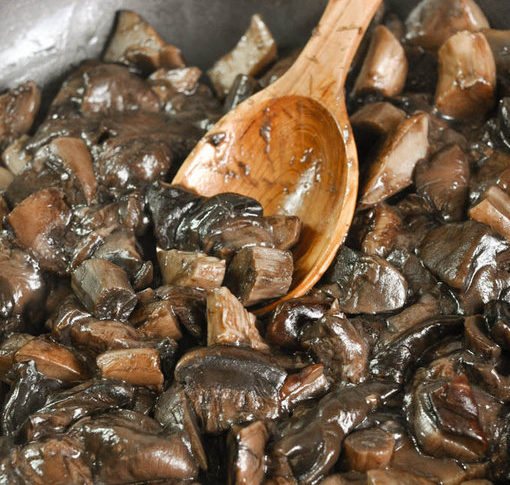

The dish is equally tasty both hot and cold. An excellent sauce for it will be sour cream with garlic and herbs.
Blanks for the winter
A variety of blanks are made from cockerels:
- pickle;
- salted;
- dried;
- fermented.
It is recommended to marinate these mushrooms so that neither salt, nor seasonings, nor acetic acid interrupt the delicate taste, but, on the contrary, emphasize it. To do this, add cumin and rosemary.


Fermented cockerels deserve special attention. The mushrooms are first blanched, washed with cold water, mixed with spices (garlic, horseradish, bay leaves, mustard seeds), and then fermented under pressure for 5-10 days. Then they are laid out in a container and stored in the refrigerator.


Characteristic features of the variety
Despite the geographically wide distribution, ringed caps are undeservedly bypassed. This is due to the caution of mushroom pickers, who confuse edible rosites with its poisonous counterparts.
Chicken mushrooms really resemble a pale toadstool with their skirt, which is shown in the photo, but after studying the description and differences, you can easily recognize an edible forest delicacy.
Appearance and structure
The appearance changes during the growth process. At the beginning of its development, the cap has the shape of a hemisphere with slightly curled edges that are attached to the stem. The diameter of the cap is up to 4 cm. As it grows, the edges diverge and break the veil, leaving a ring with a skirt on the leg against the break. The cap grows up to 10 cm in diameter and takes the form of a wide cap with a bulge in the center.
The color of the cap is brownish-pink. In dry weather, the edges of the cap dry out and crack slightly. On the inner side there are white-yellow plates of the spore apparatus, which acquire a rusty hue during the maturation of the spore powder. The outer side of the cap is dissected with thin creases covered with a light dusting. At the edge, the pollen forms scales that look like an amanita, which confuses inexperienced mushroom pickers.
The pale yellow stem has a cylindrical shape. The structure up to the ring is more silky and bright, above the ring it is scaly and pale. The pulp is dense with a pleasant mushroom smell. In the section, the color does not change.
Application
The pleasant taste and smell of the Turks, as well as the unique nutritional composition, allows them to be widely used in cooking. It is recommended to process only freshly harvested rosettes.
In folk medicine, panthers are not used. This is due to their low popularity among the population.
Cooking use
Chicken mushrooms, like champignons, are eaten in different forms. Chickens (White) are salted, pickled, fried, stewed, added to soups, meat dishes, salads, and sauces are prepared on their basis. Mushrooms frozen for the winter retain all their beneficial properties.
Before preparing the dish, the collected podolotniks are shaken off the ground, washed under running water, boiled in filtered water for 15-25 minutes.
Ringed cap is a delicious mushroom.
We collect chickens
MUSHROOM: RING CAP. Cortinarius Caperatus mushroom
Eating rules
By the structure of the flesh of the chicken, they resemble the fibers of the chicken breast. Despite the fact that the mushroom belongs to the fourth category in terms of its taste, connoisseurs of caps mark them as a delicacy dish.
Useful properties and restrictions to use
Caps, like many edible mushrooms, have medicinal properties in moderate doses, but also have a number of contraindications. Useful properties include:
- lowering cholesterol and sugar levels;
- prevention of arrhythmia;
- prevention of infectious diseases and oncology;
- normalization of blood pressure;
- pickle from mushrooms is a popular recipe for a hangover.
Among the contraindications are the following:
- chronic pancreatitis;
- dysbiosis;
- age up to 6 years (do not use at all), from 6 to 14 very carefully due to an immature enzymatic system;
- mono diets using mushrooms;
- allergic reactions, both to mushrooms, and during the period of activity of any other allergy;
- chronic diseases (reduce to use once every two weeks).
Treatment
Since chickens are edible mushrooms, it is not necessary to boil them if another cooking method is planned. It is enough to clean well from forest debris, cut off the remnants of mycelium, cut out wormy places, rinse thoroughly under running water and dry a little. The legs of the old podolotniks are not used, since they harden, and the spore apparatus on the inside is cut off in the cap, since the spores are not digested.
Cooking features
As already mentioned, it is not necessary to boil the caps, but if the collection point was close to the city or contaminated places, the mushroom should be boiled in order to remove all the accumulated dirt from it, which it picks up like a sponge.


Mushroom boiling
For this, it is important not how long to cook, but how often the water is changed. Optimally - this is to boil three times for five minutes after boiling, then drain the water. If boiling is part of the recipe, then they will be ready 10-15 minutes after boiling.
Pickling and salting
Salt pans can be hot and cold. Ideally salted in an oak barrel. To prepare a barrel for cold salting, it is necessary to wash it well and steam the juniper branches in it, which will disinfect the barrel for further manipulations.
Peeled and washed mushrooms are placed in layers in a barrel. You will need 5 kg of product for one serving. Each layer is well salted. This amount will take 350 g of salt. The contents of the barrel are filled with cold water and covered with a wooden lid of a smaller diameter for oppression. Oppression to take one that can be ignited and steamed with juniper. Within 7 days, the foam that forms in the barrel is removed.
At the end of the week, the water is drained, the barrel is rinsed with clean water and dill with seed umbrellas is placed on the bottom. A mixture is being prepared for re-salting. For 5 kg of the main ingredient, 150 g of salt, 10 g of cloves and 15 g of allspice are taken. Everything is mixed and salted on each layer. It is again poured with clean cold water and sent under oppression for 1.5 months in a dark cool room.
A faster option for hot salting. For him, you will first need to boil the peeled mushrooms for 5 minutes 2 times, changing the water. For the brine, take 2 liters of water, add 75 g of salt, 3 allspice peas, 2 pcs. cloves, 5 black peppercorns. Let the brine boil for a couple of minutes and add the mushrooms squeezed from the water there, boil for 5 minutes.
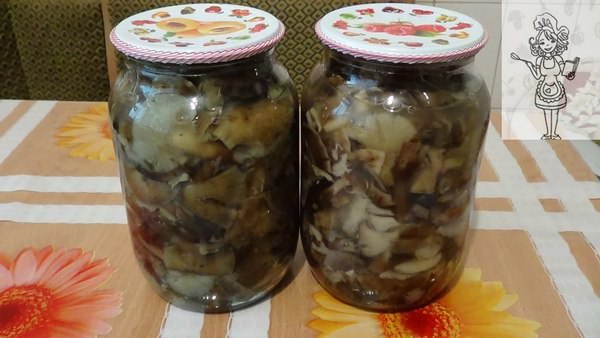

Salting chicken mushrooms
Prepare liter jars by sterilizing them beforehand.In each jar, spread over a bay leaf, 3-4 cloves of garlic, 2-3 rings of onions. Pour boiling brine with mushrooms into the jars and roll up with iron lids. After cooling, store in the refrigerator or cellar.
Edibility, useful properties and contraindications for use
You may be interested in: How to fry boletus mushrooms: simple and tasty Mushrooms ryadovki or paths: types, description, rules of collection and preparation Features of preparation of mushrooms: how to boil and pickle mushrooms
Chickens are not only edible, but also delicious. Their fragrant pulp, reminiscent of chicken meat, will help diversify the menu, with the exception of desserts. Chickens are prepared:
- soups;
- gravy;
- sauces;
- roast;
- fried foods;
- pizza and sandwiches.
In terms of nutritional value, cockerels are not inferior to mushrooms and boletus. Low calorie content (22 kcal) is combined in them with the richest chemical composition. Chickens contain a lot of ascorbic acid, macronutrients (calcium, magnesium, zinc, iron) and amino acids.


100 g of the product contains:
- 3.1 g protein;
- 0.34 g fat;
- 3.26 g carbohydrates;
- of which 1 g of fiber.
Good to know!
This mushroom is also useful in medicine. Antiviral drug of protein nature RC-28 was created from its mycelium. He successfully fights against herpes, influenza and cytomegalovirus.
Like other mushrooms, cockerels should not be collected in ecologically polluted areas, as they absorb toxins and heavy metals from the atmosphere and water. Unfortunately, not everyone can include these fruits in their diet. Chickens are contraindicated:
- pregnant and lactating;
- suffering from gastrointestinal diseases;
- preschool children.
List of edible forest mushrooms with photos and tips for novice mushroom pickers
Mushrooms are considered edible, which can be used for food absolutely without risk to life and health, since they have significant gastronomic value, distinguished by a delicate and unique taste, dishes from them do not become boring and are always in demand and popularity.
Good mushrooms are called lamellar, on the underside of the caps there are lamellar structures or spongy, since their caps on the underside resemble a sponge, inside which there are spores.
During the collection, experienced mushroom pickers always pay attention to special signs that the mushroom is edible:


the frequency of the location of the plates;- what color is the dispute;
- how the plates are attached to the leg;
- change in the color of the pulp when pressing on it.
Forest mushrooms grow from mycelium, which resembles a grayish light mold that appears on a rotting tree. Delicate fibers of the mycelium entwine the roots of the tree, creating a mutually beneficial symbiosis: the fungi get organic matter from the tree, the tree from the mycelium receives mineral nutrients and moisture. Other types of mushrooms are tied to tree species, which later determined their names.
The list contains forest mushrooms with photos and their names:
- boletus;
- bottom bearing;
- boletus;
- poddubovik;
- pine mushroom;
- speckled or common oak, others.
In coniferous and mixed forests, there are many other mushrooms that mushroom pickers are happy to find:
It is most correct to put mushrooms during collection in special wicker baskets, where they can be ventilated, in such a container it is easier for them to maintain their shape. You cannot pick mushrooms in bags, otherwise, after returning home, you can find a sticky, shapeless mass.
It is allowed to collect only those mushrooms that are known for certain that they are edible and young, old and wormy should be thrown away. It is better not to touch suspicious mushrooms at all, bypass them.
The best time to harvest is early in the morning, as long as the mushrooms are strong and fresh, they will last longer.
The use of chicken mushrooms in medicine
The useful properties of the sulfur-yellow tinder fungus make it possible to use it in medical practice. It is especially popular in Japan.Mushroom extract often acts as an active ingredient in pharmaceuticals. The main function of such medicines is to reduce weight.
In Russia, chicken mushroom is used as a natural antibiotic to fight colds and viral diseases. It is not used to treat children and pregnant women. One of the most common formats of a medicinal product is in the form of powder and herbal teas.
Characteristic features of edible mushrooms and their description
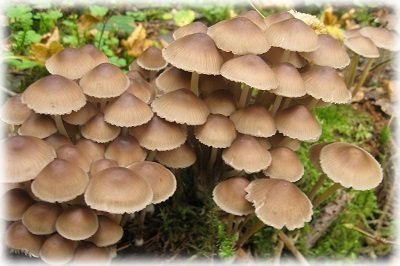

Among the noble representatives of edible, tasty and healthy mushrooms, there is a special group, which is usually characterized by one word "toadstools", because they are all poisonous or deadly poisonous, there are about 30 species of them. They are dangerous in that they usually grow in the neighborhood of edibles and are often outwardly similar to them. Unfortunately, only a few hours later it turns out that a dangerous mushroom was eaten when the person was poisoned and was admitted to the hospital.
To avoid such serious troubles, it will be useful to look through the photos, names and descriptions of edible forest mushrooms before going out on a "quiet hunt".
You can start with the first category, which includes the most noble, high-quality mushrooms with the highest taste and nutritional qualities.
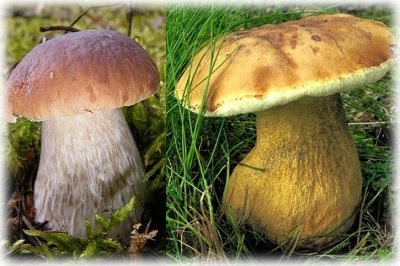

White mushroom (or boletus) - he is given the palm, he is one of the most rare among relatives, the beneficial properties of this mushroom are unique, and the taste is the highest. When the mushroom is small, it has a very light cap on top, which changes its color to yellowish brown or chestnut with age. The underside is tubular, white or yellowish, the pulp is dense, the older the mushroom becomes, the more flabby its pulp becomes, but its color does not change on the cut. This is important to know, since poisonous gall mushroom outwardly similar to white, but the surface of the spongy layer is pink, and the flesh turns red at the break. In young boletus boletuses, the legs have the shape of a drop or a barrel; with age, it changes to a cylindrical one.
It is found most often in summer, does not grow in groups, it can be found on sandy or grassy glades.
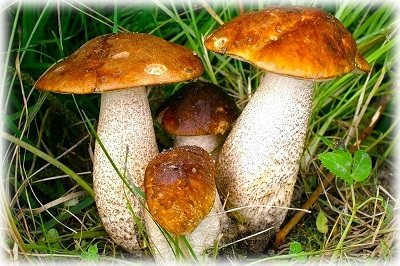

Boletus - a delicious mushroom, rich in trace elements, known as an absorbent that binds and removes harmful toxic substances from the human body. The cap of the boletus has a muted brown hue, convex, reaching a diameter of 12 cm, the leg is covered with small scales, and widened towards the base. The pulp without a specific mushroom odor, at the break acquires a pinkish tint.
Mushrooms love moist soil, it is worth following them into a birch grove after a good rain, you need to look right at the roots of birches, it is found in aspen forests.
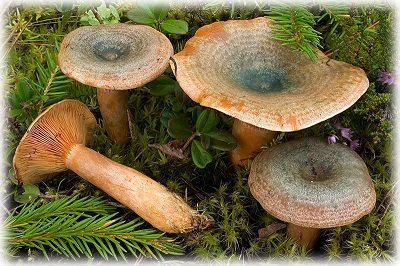

Ryzhik - the mushroom, which got its name due to its special carrot-red color, has an interesting funnel-shaped hat, with a depression in the middle, circles are visible from the depression to the edges, the lower part and the leg are also orange, the plastics turn green when pressed. The pulp is also bright orange, gives off a light resinous aroma and aftertaste, the milky juice that stands out at the break turns green, then turns brown. The taste of the mushroom is highly valued.
It prefers to grow in pine forests on sandy soils.
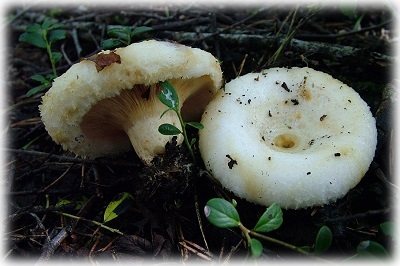

Real milk - mushroom pickers consider and call it "the king of mushrooms", although it cannot boast that it is suitable for use in various processing: basically, it is eaten only in a salted form. At a young age, the cap is flat-convex, with a slight depression, turning with age into a funnel-shaped, yellowish or greenish-white. On it there are transparent, like glassy diametrical circles - one of the characteristic signs of a lump. The plates from the stem extend to the edge of the cap, on which a fibrous fringe grows. White brittle flesh has a recognizable mushy smell, white juice, winding up, begins to turn yellow.
False doubles
Rosites dull has dangerous counterparts, so even an experienced mushroom picker should know how they might look so as not to confuse edible species with poisonous ones in the forest. You can find out about dangerous doubles like a chicken, as well as about completely edible species, their tables.
| Name | Differences | Growing places | Edibility |
| Cobweb
| The presence of fibrous remains of the bedspread on the leg | Found in mixed and coniferous forests | Inedible |
| Mushroom ram
| External differences are quite impressive: the mushroom has a different shape, consists of numerous flat, thin, semicircular or spatulate caps 4-10 cm in diameter, sitting on repeatedly branching legs, which merge into a common base. These species have only a common popular name. | Grows from late June to late September in broadleaf | Edible, very rare |
| Forest mushroom
| When broken, the pulp turns red, the plates are first white, then reddish, the cap is rusty-brown-brown. | It grows from July to October in coniferous and mixed forests, especially often found near ant heaps. | Edible |
| Death cap | White cap, loose, white plates, swollen at the base of the leg, having a volva and a white filmy ring | Widely distributed in the temperate zone of Europe and Asia. Grows in deciduous forests from late summer until November. | Poisonous |
| Fly agaric
| There are whitish scales and a powdery coating on the cap, an ocher color of a spore powder (poisonous fly agarics have a white spore powder), and the absence of a volva. In old specimens of the ringed cap, the hymenophore is rusty-brown, while in fly agarics it remains white until old age. | In Russia, it is widespread. The growing season is from August to October. | Poisonous |
Photos will help you recognize poisonous relatives.
Reference! The chicken mushroom has a "namesake" - a kvochka mushroom, a ram mushroom, a mushroom cabbage, a coral mushroom, a kvochka mushroom, a wild hen, a dancing mushroom, a turkey tail or curly griffin. Despite the similar name, they are completely different species. The bushy shoots of the pseudo-caps Griffins have distinctly prominent legs and visually resemble cauliflower or coral bushes.
Raising cockerels
These mushrooms are delicious and easy to pick and cook. It is not surprising that such a delicious representative of the mushroom kingdom is grown artificially.
Growing on stumps
For cultivation, most often, the stumps left after tree felling are used. Growing order:
- First you need to get the spores. The hats of ripe cockerels are laid on a sheet of paper so that the spores get enough sleep. Pour the resulting seed into a small container with water.
- Water with spores is poured onto the stumps.
- From time to time, the stumps are poured with water.
Chickens grow best on pine, spruce, birch and aspen stumps or logs of these species.
They "infect" the substrate with fragments of rotten stumps with mycelium of the cockerels that have grown on them. Take "seed" in the area where chickens grow in colonies. Methods of infection with fragments of stumps with mycelium:
- In the infected stumps, cavities are made - grafting wood is laid there.
- The material with mycelium can also be nailed to the end of the stumps. And to preserve moisture, the graft mycelium is covered with spruce paws or pieces of moss.
It is possible to grow chickens in this way during the entire growing season. Unless in heat and drought, you should not hope for a harvest. The mushroom grows best in spring and summer. Amateur mushroom growers say that the caps grow on the infected material for 5-8 years.
Growing on chocks and wood waste
Also caps can be grown:
- On wooden chocks. Take round pieces of wood with a length of 30-40 cm and a diameter of 15 cm. Harvesting of pieces of wood is carried out in spring or autumn. Moreover, only freshly cut trees are suitable. Chocks infect like stumps.But they must first be kept in a dark room. The aging period is 2-3 months. Favorable temperature 15-20 ° C. Next, the chocks are placed vertically in pits 20 cm deep. The interval for laying is 50 cm. Infected places, like on stumps, are covered with spruce paws. Here the males will bear fruit twice a year for 2-3 years.
- On wood waste... The method is good for indoor growing. You can use shavings, wood chips, sawdust - they are laid in glass jars or pots. They take sawdust and shavings. Mix and pour boiling water over. Starch (7.5 g per 1 kg of mixture), bean flour (15 g), oatmeal and corn flour (25 g each) are added. The mixture is laid out in sterilized jars. Sterilization time - 1 hour.
For breeding, you can use wooden crates or plastic bags. Nutritional supplements vary. Along with flour and starch, you can use:
- beer wort;
- malt;
- potato pulp.
Petushki is a delicacy product that deserves the attention of mushroom gourmets. Behind an unpresentable view, there is an amazingly tasty mushroom, which in the food rating can easily stand next to champignons and porcini mushrooms.
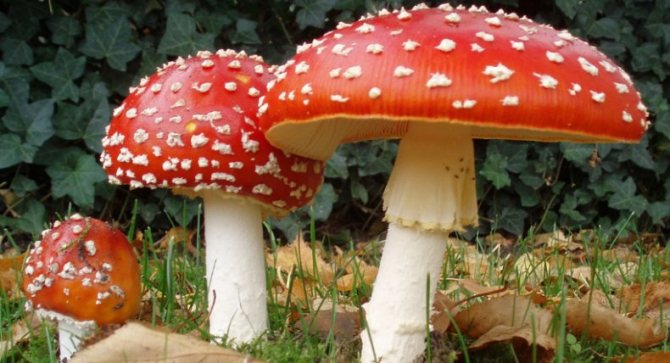

Fly agaric
How to cook an umbrella mushroom?
The umbrella mushroom, or rather its hat, is very tasty. The stem of this mushroom is discarded as it is made up of long, tough fibers. Try frying the hat in vegetable oil. I am sure that you will like it so much that the umbrella will become one of your favorite mushrooms. I happily eat a hat that is well fried on both sides (like a pancake). First from the side of the plates. You can pre-roll it in flour, bread crumbs or beaten egg. This mushroom (fresh and dry) is also good for soup. Young umbrellas are salted and pickled. The umbrella is prepared quickly, almost like champignons. Some people eat this mushroom raw, using it in salads or making sandwiches with it. Scales on the cap do not need to be removed. Gourmets cook an umbrella mushroom not only in a frying pan, but also on the grill of the oven (with a tray) or barbecue. Necessarily with herbs, pepper and garlic. It turns out very tasty.
How much to cook chicken mushrooms before harvesting
There are a lot of disputes between the hostesses about how long it takes to cook a ringed cap. Some argue that it is necessary to cook, changing the water three times, others insist that these mushrooms can not be boiled at all. In fact, the main prescription for cockerel cooking is the polluted collection area.
Like any other mushroom, the caps like a sponge absorb all the dirt from the soil and their environment. Therefore, it is not recommended to collect near roads and factories. The closer to the roadway the cockerel grows, the longer it needs to be cooked, and the procedure does not consist in the duration of cooking, but in the number of times the water is changed.
Read also: How to make a garage door made of wood
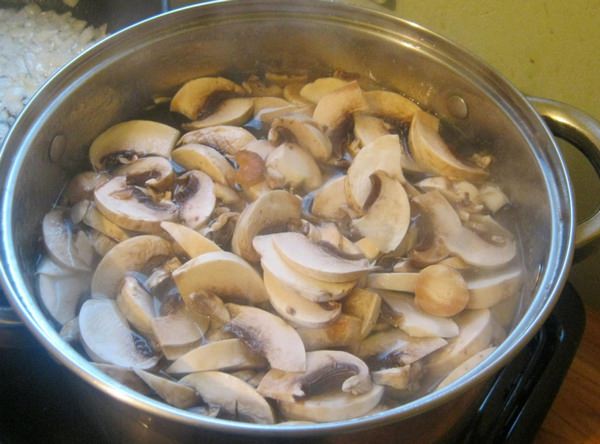

There are a lot of disputes between the hostesses about how long it takes to cook a ringed cap
If you collected the caps in a mixed forest and decided to salt it, it will be enough to change the water 3 times by boiling the mushrooms for 5 minutes.
If they were collected in an ecologically clean area, far from factories and roads, they may not be boiled at all.
In the case of pickling, the situation is a little different, here the ringed cap will need to be boiled for 20 minutes, and then another couple of minutes. in the marinade.
What mushrooms can be confused with
The ringed cap can be confused with inedible mushrooms from the Spiderweb genus. However, edibles have a very important difference - there is always a full-fledged ring on their stem, which is not the case with poisonous ones. They have only small remnants of the bedspread on the leg. Sometimes cockerels are confused with a pale toadstool or fly agaric.
So that you can distinguish them from their deadly counterparts, here are some important signs:
Distribution locations
Chicken mushrooms, the photo of which shows that they very much resemble some species of voles, for example, early or tough, forms mycorrhiza mainly with conifers, although they are found no less often under oak or birch trees. In the middle zone of our country, they can be collected in mossy areas in pine or mixed forests.
In mountain ranges, they are found even at an altitude of two thousand meters. Chicken mushrooms are most common in Western Europe and Belarus. In our country, they are more often found in damp forest areas of Central Russia on ash and podzolic soil types. These mushrooms love to inhabit mixed forests, but they are often found in pure conifers, if, of course, it is humid enough there and all the necessary conditions for reproduction and growth are present.


